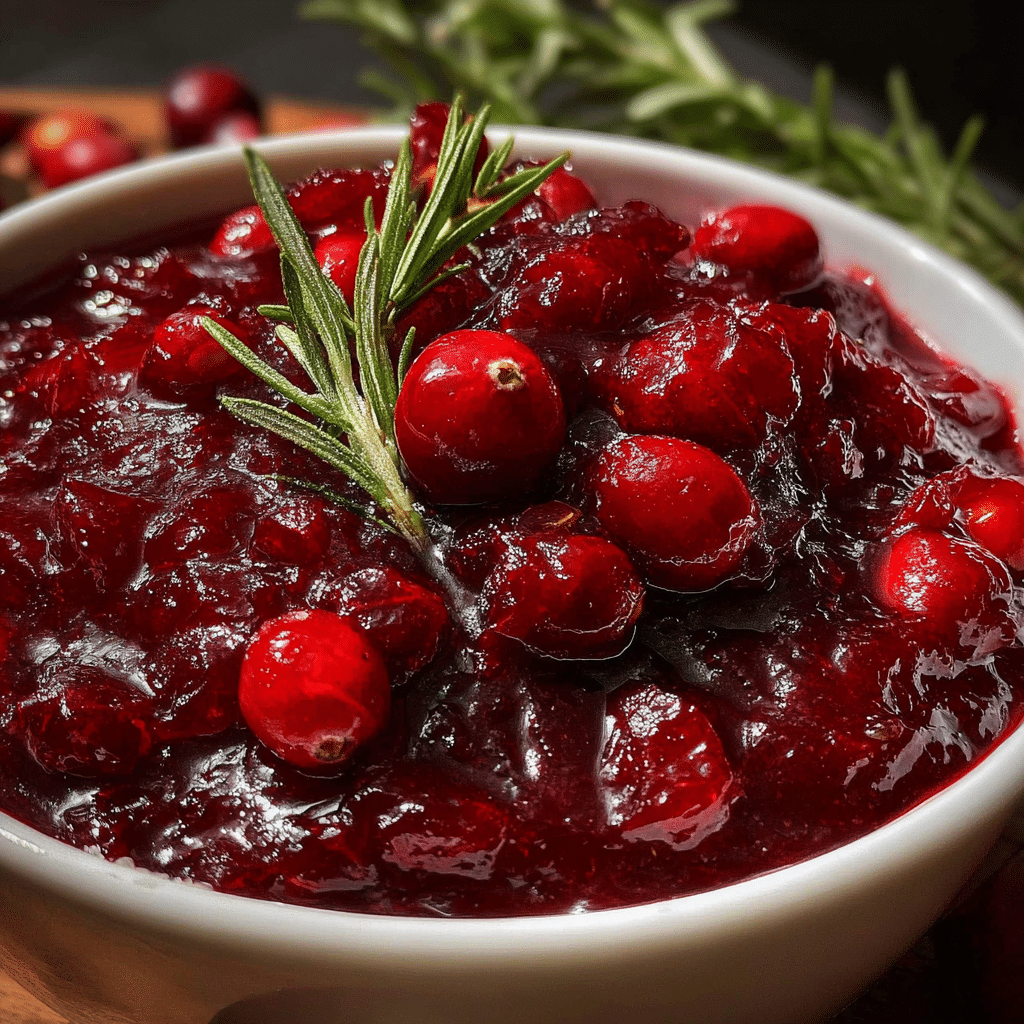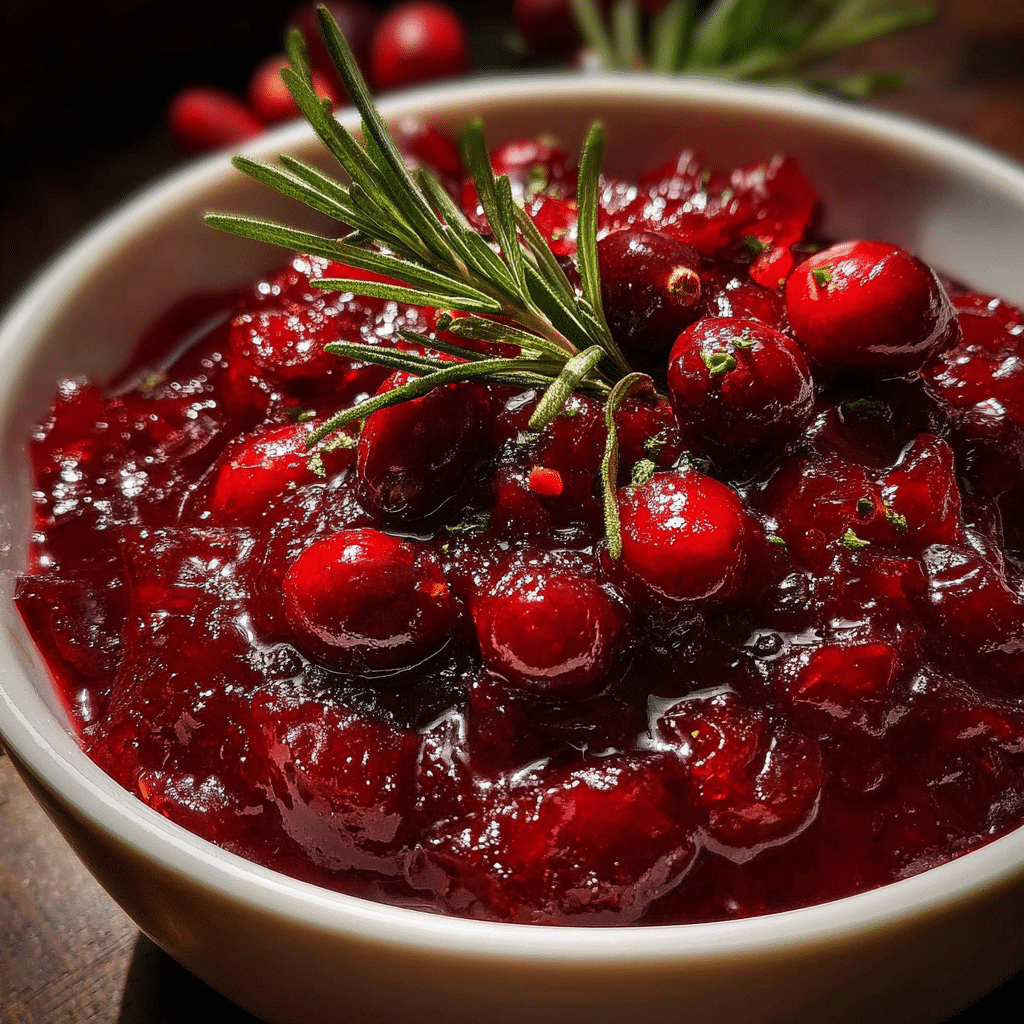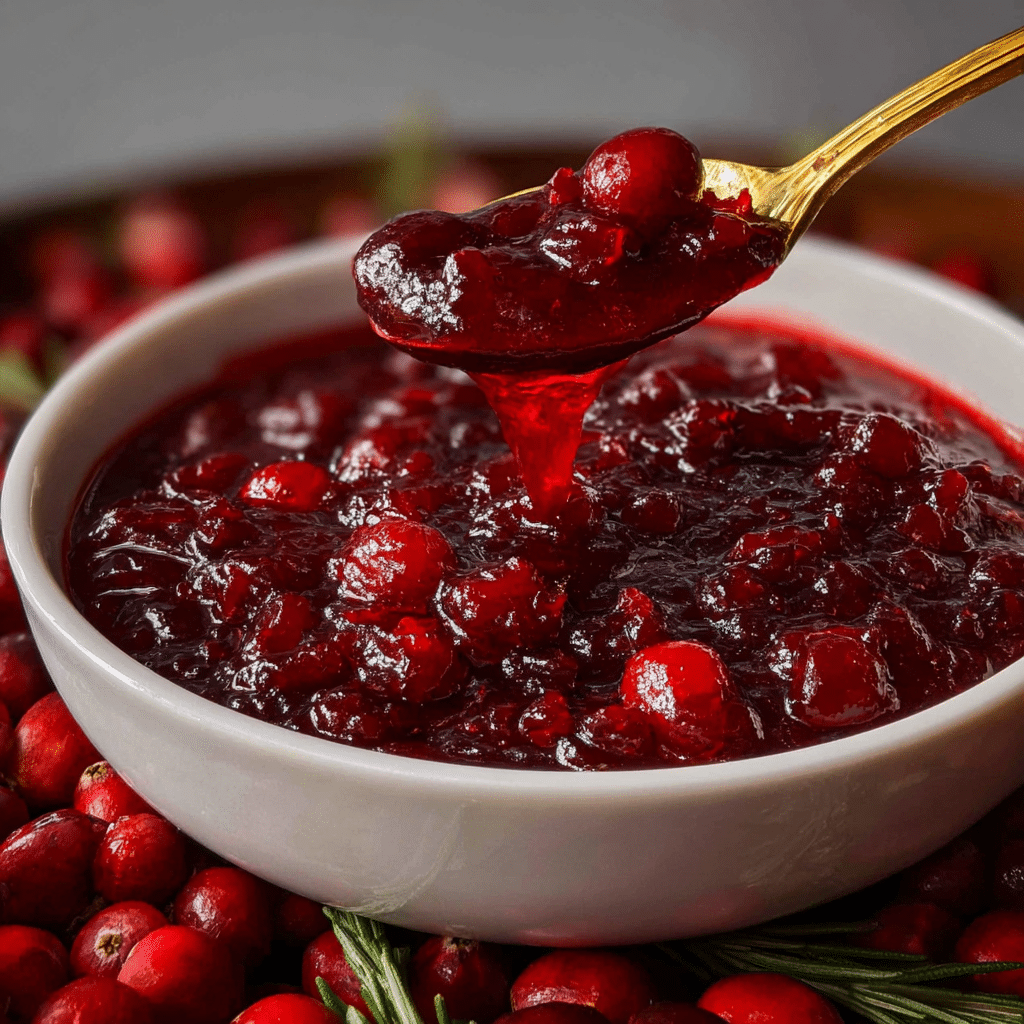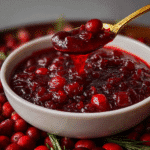Cranberry sauce – the quintessential holiday side dish that can make or break your festive feast. Are you tired of serving that gelatinous, overly sweet canned version that slides out in the shape of the can? Hi there! I’m Lisa, the heart and soul behind Recipesrealm, and I’m absolutely thrilled to share my perfected homemade cranberry sauce recipe that will transform your holiday table forever.
After years of experimenting in my kitchen and hearing countless stories from fellow home cooks about cranberry sauce disasters, I’ve mastered this simple yet elegant recipe that delivers the perfect balance of tart and sweet flavors. This fresh cranberry sauce recipe creates a vibrant, chunky texture with beautiful ruby-red color that will have your guests asking for the recipe before they’ve even finished their first bite.
As someone who’s been perfecting holiday recipes for over a decade, I can confidently say that homemade cranberry sauce is one of the easiest ways to elevate your entire meal. Whether you’re hosting Thanksgiving dinner for the first time or you’re a seasoned entertainer looking to upgrade your traditional sides, this recipe delivers foolproof results every time.
In this comprehensive guide, I’ll walk you through everything you need to know about creating the perfect cranberry sauce, from selecting the best cranberries to mastering cooking techniques, exploring flavor variations, and even troubleshooting common problems. You’ll discover why this recipe works so beautifully, learn professional tips that ensure success, and find creative ways to customize it for your family’s taste preferences.
Why This Cranberry Sauce Recipe Works
Creating the perfect homemade cranberry sauce might seem intimidating, but this recipe eliminates all the guesswork while delivering restaurant-quality results. After testing countless variations and techniques, I’ve discovered the key elements that make this cranberry sauce exceptional every single time.
The magic lies in the carefully balanced ingredient ratios and the gentle cooking method that preserves the cranberries’ natural texture while developing complex flavors. Unlike many recipes that rely on excessive sugar or complicated techniques, this approach celebrates the beautiful tartness of fresh cranberries while adding just enough sweetness to create harmony.
Here’s why this cranberry sauce recipe consistently delivers outstanding results:
• Uses readily available fresh cranberries – No need to hunt for specialty ingredients or worry about seasonal availability during holiday season • Quick 15-minute cooking time – Perfect for busy holiday preparation schedules when every minute counts • Versatile base recipe – Easily customizable with spices, citrus, or other flavor additions to match your family’s preferences • Make-ahead friendly – Actually improves in flavor when prepared 1-2 days in advance, reducing holiday stress • Natural pectin creates perfect consistency – Cranberries naturally thicken without artificial additives or complicated techniques • Beautiful presentation – Vibrant color and chunky texture make it an attractive addition to any holiday spread
The secret to this recipe’s success is the controlled cooking process that allows the cranberries to burst naturally, releasing their pectin while maintaining some whole berries for textural interest. This creates that perfect balance between smooth and chunky that makes homemade cranberry sauce so much more appealing than store-bought versions.
Choosing the Right Cranberries for Your Cranberry Sauce
Selecting quality cranberries is absolutely crucial for achieving the best results in your homemade cranberry sauce. The quality of your main ingredient directly impacts the final flavor, texture, and appearance of your finished dish, so it’s worth taking time to choose wisely.
Best Cranberries for This Recipe
Fresh cranberries are always the preferred choice for homemade cranberry sauce, offering superior flavor and texture compared to frozen alternatives. When shopping for fresh cranberries, you’ll typically find them in 12-ounce bags during the holiday season, usually from October through December in most grocery stores.
Look for cranberries that are firm, plump, and have a deep red color with a slight sheen. The best cranberries should bounce when dropped – this is actually a quality test that cranberry growers use professionally. Avoid berries that appear shriveled, soft, or have dark spots, as these indicate age or potential spoilage.
Fresh cranberries should feel heavy for their size and make a slight rattling sound when you shake the bag. The packaging should be free from moisture or condensation, which could indicate that the berries have been stored improperly or are past their prime.
Buying Tips for Perfect Cranberry Sauce
When shopping for cranberries, timing can make a significant difference in quality and price. Purchase your cranberries as close to your cooking date as possible, though they can be stored in the refrigerator for up to four weeks if kept in their original packaging.
If you find high-quality cranberries on sale, consider buying extra bags to freeze for later use. Simply place unopened bags directly in the freezer, where they’ll maintain quality for up to one year. Frozen cranberries can be used directly in cooking without thawing, though they may release slightly more liquid during the cooking process.
Check multiple stores if possible, as cranberry quality can vary significantly between suppliers and harvest dates. Organic cranberries often have excellent flavor, though they may be more expensive and can vary in size more than conventional varieties.
Substitutions for Your Cranberry Sauce
While fresh cranberries are ideal, frozen cranberries work exceptionally well in this recipe and are often more affordable. Use frozen cranberries directly from the freezer without thawing – they’ll break down slightly more during cooking, creating a smoother texture that many people prefer.
If you can only find sweetened dried cranberries, they can be rehydrated and used in a pinch, though the flavor profile will be quite different. Soak dried cranberries in warm water for 30 minutes, then drain before using. You’ll need to reduce the sugar in the recipe significantly since dried cranberries already contain added sweeteners.
Some creative cooks substitute other tart berries like lingonberries or even a mix of cranberries with pomegranate seeds for unique flavor variations. While these won’t create traditional cranberry sauce, they can offer interesting alternatives for adventurous palates.

Ingredients & Prep for Perfect Cranberry Sauce
Creating exceptional homemade cranberry sauce starts with proper ingredient selection and preparation. This recipe’s beauty lies in its simplicity – just a few high-quality ingredients combine to create something truly special that will elevate your entire holiday meal.
Essential Cranberry Sauce Ingredients
The foundation of perfect cranberry sauce requires only a handful of carefully chosen ingredients, each playing a crucial role in the final flavor and texture:
• Fresh cranberries (12 oz bag) – The star ingredient providing tart flavor and natural pectin for thickening • Granulated sugar (3/4 to 1 cup) – Balances the cranberries’ natural tartness; adjust to taste preferences • Fresh orange juice (1/2 cup) – Adds bright citrus notes and helps prevent the sauce from becoming too thick • Orange zest (1 tablespoon) – Provides aromatic oils and intensifies citrus flavor without adding liquid • Fresh water (1/4 cup) – Helps start the cooking process and prevents initial sticking • Kosher salt (pinch) – Enhances all other flavors and balances sweetness
Optional flavor enhancers that can elevate your cranberry sauce include: • Fresh ginger (1 teaspoon grated) – Adds warm spice and complexity • Cinnamon stick (1 whole) – Infuses gentle warming spice throughout cooking • Vanilla extract (1/2 teaspoon) – Adds depth and rounds out flavors • Chopped toasted nuts – Pecans or walnuts add textural interest
Cranberry Sauce Prep Essentials
Proper preparation ensures your cranberry sauce cooks evenly and develops the ideal texture. Start by thoroughly rinsing your fresh cranberries in cold water, removing any stems, damaged berries, or debris. Don’t worry about drying them completely – a little residual water actually helps the initial cooking process.
Sort through the cranberries carefully, discarding any that are soft, wrinkled, or discolored. This step is crucial because even a few overripe berries can affect the overall flavor and appearance of your finished sauce. Quality cranberries should be firm and bounce when dropped.
Measure your sugar accurately, but remember that you can always adjust sweetness during cooking. Start with the smaller amount and taste as you go – you can always add more, but you can’t take it away. Some cranberry batches are naturally more tart than others, so flexibility is key.
Make-Ahead Tips for Cranberry Sauce Success
One of the greatest advantages of homemade cranberry sauce is its make-ahead potential. In fact, the flavors actually improve after a day or two of refrigerated storage, making it perfect for holiday meal preparation.
Prepare your cranberry sauce up to three days before serving, storing it covered in the refrigerator. The sauce will continue to thicken slightly as it cools and the flavors will meld beautifully. This also allows you to focus on other dishes during the busy holiday cooking schedule.
If you want to prepare even further in advance, cranberry sauce freezes beautifully for up to three months. Cool the sauce completely before transferring to freezer-safe containers, leaving about an inch of headspace for expansion. Thaw overnight in the refrigerator before serving.
Step-by-Step Cranberry Sauce Cooking Instructions
Creating perfect homemade cranberry sauce is surprisingly straightforward when you follow the proper technique. This step-by-step process ensures consistent results every time, taking you from fresh cranberries to restaurant-quality sauce in just about 15 minutes of active cooking time.
Pre-Cooking Prep for Cranberry Sauce
Before you begin cooking your cranberry sauce, gather all ingredients and equipment to ensure a smooth cooking process. You’ll need a heavy-bottomed saucepan (at least 2-quart capacity), a wooden spoon for stirring, and a fine-mesh strainer for the final texture check if desired.
Rinse the cranberries thoroughly under cold running water, picking out any stems or damaged berries. Place them in a bowl near your cooking area along with your measured sugar, orange juice, and other ingredients. Having everything ready before you start cooking prevents overcooking while you search for ingredients.
Zest your orange before juicing it – it’s much easier to zest a whole orange than one that’s been cut. Use a microplane grater or the finest holes on a box grater, being careful to only remove the colorful outer layer and avoid the bitter white pith underneath.
Cooking Method for Perfect Cranberry Sauce
Heat your saucepan over medium heat and add the water, orange juice, and sugar, stirring until the sugar begins to dissolve. This creates the cooking liquid that will gently cook the cranberries and develop into your sauce base.
Add the cranberries to the hot liquid and stir gently to coat them evenly. You’ll hear them start to sizzle slightly – this is normal and indicates they’re beginning to heat through. Don’t increase the heat to speed the process, as gentle cooking produces the best texture.
Within 3-5 minutes, you’ll begin to hear the cranberries start to pop – this distinctive sound indicates that their skins are bursting and releasing their natural juices and pectin. Continue cooking, stirring occasionally, as more berries pop and the mixture becomes increasingly liquid.
Cook for 10-12 minutes total, stirring every 2-3 minutes to prevent sticking. The sauce is ready when most berries have burst, the liquid has reduced slightly, and the mixture coats the back of your spoon. Some whole cranberries should remain for textural interest.
Doneness Check for Your Cranberry Sauce
Determining when your cranberry sauce is perfectly cooked requires attention to both visual and texture cues. The mixture should have a glossy, jam-like consistency that coats your stirring spoon without being too thick or too thin.
Most of the cranberries should have burst and released their juices, but you should still see some whole or partially whole berries throughout the sauce. This creates the ideal texture contrast that makes homemade cranberry sauce so much more interesting than smooth commercial versions.
The sauce will continue to thicken as it cools due to the natural pectin in the cranberries, so don’t overcook trying to achieve the final consistency while it’s still hot. It should be pourable when hot but will set to a spreadable consistency when cooled.
Cooling and Final Touches for Cranberry Sauce
Remove the saucepan from heat and stir in the orange zest, salt, and any additional flavorings like vanilla or ginger. These final additions provide the brightest, most aromatic flavors that distinguish restaurant-quality cranberry sauce from basic versions.
Taste the hot sauce carefully and adjust sweetness if needed. Remember that the sauce will taste less sweet when cold, so add sugar conservatively. If the sauce seems too tart, add sugar one tablespoon at a time; if too sweet, add a squeeze of fresh lemon juice to brighten the flavors.
Allow the cranberry sauce to cool to room temperature before refrigerating. It will thicken considerably as it cools, reaching its final consistency after about 2 hours of refrigeration. Serve at room temperature or slightly chilled for the best flavor and texture.
Pro Tips for Perfect Cranberry Sauce
After years of perfecting this cranberry sauce recipe and helping countless home cooks master the technique, I’ve discovered several professional secrets that consistently elevate the final results. These insider tips transform a good cranberry sauce into an exceptional one that will have your guests raving.
Avoiding Common Cranberry Sauce Mistakes
The most frequent mistake home cooks make when preparing cranberry sauce is cooking it at too high heat, which causes the cranberries to burst too rapidly and creates a mushy texture. Medium heat allows the berries to cook gently, maintaining some structural integrity while developing complex flavors.
Another common error is adding all the sugar at once without tasting during cooking. Cranberry tartness can vary significantly between batches, so start with less sugar and adjust gradually. This approach ensures you achieve the perfect sweet-tart balance that makes cranberry sauce so appealing.
Overcooking is perhaps the biggest culprit behind disappointing cranberry sauce. The cooking process should stop when most berries have popped but some remain whole. The sauce will continue to thicken as it cools, so what seems too thin when hot will be perfectly set when served.
Essential Cranberry Sauce Tools and Equipment
While cranberry sauce doesn’t require specialized equipment, using the right tools makes the process easier and produces better results. A heavy-bottomed saucepan distributes heat evenly and prevents hot spots that can cause scorching or uneven cooking.
A wooden spoon is ideal for stirring cranberry sauce because it won’t react with the acidic fruit and allows you to feel when the berries are starting to break down. The rounded edge also helps prevent crushing berries prematurely, maintaining better texture control.
A fine-mesh strainer can be useful if you prefer a smoother sauce, though most people enjoy the rustic texture of unstrained homemade cranberry sauce. For serving, choose a attractive bowl that complements your table setting – cranberry sauce’s beautiful color deserves to be showcased.
Storage and Reheating Your Cranberry Sauce
Proper storage extends the life of your homemade cranberry sauce and maintains its quality for maximum enjoyment. Store cooled cranberry sauce in the refrigerator for up to one week, covered tightly to prevent absorption of other flavors.
For longer storage, cranberry sauce freezes beautifully for up to three months. Use freezer-safe containers and leave about an inch of headspace to allow for expansion. Label with the date and contents for easy identification later.
When reheating refrigerated cranberry sauce, let it come to room temperature naturally for the best flavor and texture. If you prefer it slightly warm, heat gently in a small saucepan over low heat, stirring occasionally. Avoid microwave reheating, which can create hot spots and uneven texture.

Flavor Variations for Your Cranberry Sauce
One of the most exciting aspects of making homemade cranberry sauce is the endless possibilities for customization. This versatile base recipe serves as a foundation for numerous flavor variations that can complement different menu themes or satisfy various taste preferences within your family.
Spicy Cranberry Sauce Variations
Transform your traditional cranberry sauce into an exciting, heat-forward condiment by incorporating carefully chosen spicy elements. Fresh jalapeño peppers, seeded and finely minced, add a bright, fresh heat that complements the cranberries’ tartness beautifully without overwhelming the fruit flavors.
For a smokier heat profile, try adding finely chopped chipotle peppers in adobo sauce. Start with just half a pepper and a teaspoon of the adobo sauce, tasting as you go. The smoky, sweet heat of chipotles creates a sophisticated flavor complexity that pairs especially well with roasted meats.
A pinch of cayenne pepper or red pepper flakes offers a more traditional heat approach, while fresh grated ginger provides warming spice with aromatic complexity. These variations work particularly well when serving cranberry sauce with rich, fatty dishes that benefit from a spicy counterpoint.
International Cranberry Sauce Flavors
Explore global flavor profiles by incorporating international spice combinations and ingredients. A Middle Eastern-inspired version combines warm spices like cinnamon, cardamom, and a hint of rose water for an exotic twist that pairs beautifully with lamb or other rich meats.
Asian-inspired cranberry sauce incorporates fresh ginger, a splash of rice vinegar, and a touch of sesame oil for umami depth. This variation complements roasted duck or other poultry dishes exceptionally well, bridging the gap between traditional American holiday flavors and Asian cuisine.
Mediterranean influences shine through when you add fresh herbs like rosemary or thyme, along with a splash of balsamic vinegar and perhaps some toasted pine nuts. This sophisticated variation elevates any cheese board or charcuterie presentation.
Dietary-Friendly Cranberry Sauce Options
Creating delicious cranberry sauce variations that accommodate different dietary needs ensures everyone at your table can enjoy this holiday staple. For those following ketogenic or low-carb diets, replace traditional sugar with erythritol or stevia, adjusting quantities to taste since these sweeteners have different intensities.
Paleo-friendly versions use raw honey or pure maple syrup as natural sweeteners, though you’ll need to adjust cooking times slightly since these liquid sweeteners can affect the final consistency. The result is a more complex, nuanced sweetness that many people prefer over refined sugar.
For those avoiding refined sugars entirely, consider using fresh apple juice concentrate or pureed dates as natural sweetening agents. These options add their own flavor notes while providing the sweetness needed to balance the cranberries’ natural tartness.
| Flavor Variation | Main Additions | Best Pairing | Cooking Notes |
|---|---|---|---|
| Classic Traditional | Orange zest, vanilla | Turkey, stuffing | Standard recipe, perfect baseline |
| Spicy Jalapeño | Fresh jalapeño, lime zest | Pork, spicy dishes | Remove seeds for less heat |
| Warm Spiced | Cinnamon, nutmeg, cloves | Ham, root vegetables | Add spices in last 2 minutes |
| Ginger Orange | Fresh ginger, extra orange | Duck, rich meats | Grate ginger finely for best texture |
| Maple Pecan | Pure maple syrup, toasted pecans | Sweet potatoes, desserts | Add nuts after cooling to maintain crunch |
| Pomegranate | Pomegranate juice, seeds | Cheese boards, appetizers | Reduce other liquid slightly |
Serving Suggestions for Your Cranberry Sauce
The versatility of homemade cranberry sauce extends far beyond its traditional role as a holiday side dish. Understanding how to serve and pair this vibrant condiment opens up numerous possibilities for enhancing meals throughout the year and creating memorable dining experiences.
Classic Holiday Cranberry Sauce Pairings
Traditional holiday presentations showcase cranberry sauce alongside roasted turkey, where its bright acidity cuts through rich, fatty skin and provides a palate-cleansing contrast. Serve it in an attractive bowl with a small spoon, allowing guests to add their preferred amount to their plates.
The sauce also pairs beautifully with stuffing, where its fruity sweetness complements savory herb flavors and adds moisture to drier bread-based dishes. Consider offering it alongside other traditional sides like mashed potatoes, where a small dollop adds color and brightness to the plate.
For a more refined presentation, serve cranberry sauce in individual small ramekins at each place setting, or create an attractive condiment station with various homemade sauces and accompaniments. This approach elevates the dining experience and shows attention to detail that guests will appreciate.
Creative Cranberry Sauce Applications
Transform leftover cranberry sauce into gourmet sandwich spreads by mixing it with cream cheese or goat cheese for turkey and brie sandwiches. The combination creates a sophisticated flavor profile that works beautifully on artisanal breads or croissants.
Use cranberry sauce as a glaze for roasted meats during the final minutes of cooking. Brush it over chicken thighs, pork tenderloin, or even salmon for a beautiful glossy finish and complex flavor layer. The natural sugars caramelize slightly, creating an appealing appearance and taste.
Incorporate cranberry sauce into cheese boards and charcuterie presentations, where it provides a sweet-tart element that complements aged cheeses, cured meats, and nuts. Its beautiful color also adds visual appeal to these artful arrangements.
Beverage Pairings with Cranberry Sauce
When serving cranberry sauce as part of a larger meal, consider beverages that complement its bright, tart flavors without competing. Crisp, dry beverages work exceptionally well, cleansing the palate and preparing it for the next bite.
Sparkling cider or champagne provides effervescence that lightens rich holiday meals while echoing the fruit flavors in the sauce. The bubbles help cleanse the palate between bites, making each taste of cranberry sauce as bright as the first.
For non-beverages, consider sparkling water with a splash of fresh citrus, or even cranberry juice mixed with sparkling water for a festive mocktail that echoes the sauce’s flavors without overwhelming the meal.

FAQs About Perfect Cranberry Sauce
Over the years of sharing this cranberry sauce recipe and helping home cooks perfect their technique, certain questions arise repeatedly. These frequently asked questions address the most common concerns and curiosities about creating exceptional homemade cranberry sauce.
Can I Use Frozen Cranberries for Cranberry Sauce?
Absolutely! Frozen cranberries work excellently in this cranberry sauce recipe and are often more convenient and cost-effective than fresh ones. Use them directly from the freezer without thawing – they’ll actually break down slightly more during cooking, which many people prefer for a smoother texture.
The main difference with frozen cranberries is that they may release a bit more liquid initially, so you might need to cook the sauce a minute or two longer to achieve the proper consistency. The flavor remains virtually identical to using fresh cranberries, making frozen ones an excellent option year-round.
Keep in mind that frozen cranberries may create a slightly softer final texture since the freezing process breaks down some cell walls. If you prefer chunkier cranberry sauce with more whole berries, fresh cranberries are your best choice.
How Do I Fix Runny Cranberry Sauce?
If your cranberry sauce seems too thin or runny, remember that it will thicken considerably as it cools due to the natural pectin in the cranberries. Allow it to cool completely before determining if additional thickening is needed – what seems thin when hot often reaches perfect consistency when cold.
For sauce that remains too thin after cooling, return it to the saucepan and simmer gently over low heat for 2-3 additional minutes, stirring frequently. The extra cooking time will evaporate excess liquid and concentrate the flavors while activating more natural pectin.
If you need to thicken cranberry sauce immediately for serving, mix one teaspoon of cornstarch with two teaspoons of cold water to create a slurry. Stir this into the hot sauce and cook for one minute until thickened. This method works quickly but may slightly alter the sauce’s natural clarity.
How Long Does Homemade Cranberry Sauce Last?
Properly stored homemade cranberry sauce maintains excellent quality in the refrigerator for up to one week when kept in a covered container. The high acid content of cranberries naturally helps preserve the sauce, though proper storage is still important for food safety.
For longer storage, cranberry sauce freezes beautifully for up to three months without significant quality loss. Use freezer-safe containers and leave about an inch of headspace to allow for expansion. Label containers with dates for easy identification and rotation.
Signs that cranberry sauce has spoiled include off odors, visible mold growth, or changes in texture or color. When in doubt, discard the sauce rather than risk foodborne illness. Fresh cranberry sauce should maintain its bright color and fresh, fruity aroma throughout its storage life.
Can I Reduce the Sugar in This Cranberry Sauce Recipe?
Yes, you can definitely adjust the sugar content in this cranberry sauce recipe to suit your taste preferences or dietary needs. Start with the smaller recommended amount (3/4 cup) and taste during cooking, adding more only if needed for your preferred sweetness level.
Keep in mind that cranberries are naturally quite tart, and some sweetness is necessary to balance their intensity and create an appealing flavor profile. Reducing sugar too dramatically may result in a sauce that’s unpleasantly sour for most palates.
For those avoiding refined sugar entirely, consider natural alternatives like pure maple syrup, honey, or even unsweetened apple juice concentrate. These substitutions will create slightly different flavor profiles but can produce delicious results when used thoughtfully.
Is This Cranberry Sauce Recipe Safe for Pregnant Women?
This homemade cranberry sauce recipe is perfectly safe for pregnant women when prepared and stored properly. The recipe contains no raw ingredients, unpasteurized products, or other items typically restricted during pregnancy.
In fact, cranberries offer several nutritional benefits including vitamin C, antioxidants, and fiber that can be valuable during pregnancy. The natural fruit provides nutrients while the cooking process ensures food safety through proper heat treatment.
As with all foods during pregnancy, practice good food safety by using clean utensils and storage containers, refrigerating leftovers promptly, and consuming the sauce within the recommended timeframe to minimize any risk of foodborne illness.
Conclusion
Creating the perfect homemade cranberry sauce is one of the most rewarding and surprisingly simple ways to elevate your holiday table and impress your guests. This comprehensive guide has taken you through every aspect of crafting restaurant-quality cranberry sauce from basic ingredient selection to advanced flavor variations and professional techniques.
The beauty of this recipe lies not just in its simplicity, but in its incredible versatility and make-ahead convenience. Whether you’re preparing for your first Thanksgiving dinner or you’re a seasoned cook looking to upgrade your traditional sides, this cranberry sauce delivers consistent, exceptional results that will have everyone asking for your secret.
Remember that the key to success lies in using quality ingredients, maintaining gentle heat during cooking, and allowing the natural pectin in the cranberries to work its magic. The balance of sweet and tart, the beautiful ruby color, and the satisfying texture of homemade cranberry sauce simply cannot be replicated by commercial versions.
As you experiment with the various flavor combinations and serving suggestions outlined in this guide, you’ll discover that cranberry sauce is far more versatile than its traditional holiday role suggests. From sandwich spreads to meat glazes, from cheese board accompaniments to creative cocktail ingredients, your homemade cranberry sauce will find uses throughout the year.
The confidence you’ll gain from mastering this fundamental recipe will inspire you to tackle other homemade condiments and sides, gradually building a repertoire of signature dishes that define your personal cooking style. Each time you serve this cranberry sauce, you’re not just providing a delicious accompaniment – you’re creating memories and continuing culinary traditions that bring people together around the table.
Fire up your stovetop and try this recipe tonight! Whether it’s holiday season or just a regular Tuesday, fresh cranberry sauce adds brightness and sophistication to any meal. Join the thousands of home cooks who’ve already discovered how much more delicious homemade truly is compared to store-bought alternatives.
If you loved this recipe, don’t forget to share it with your friends or save it to try later! I’d be thrilled to see your personal touch—share your photos on Pinterest
Print
Easy Fresh Homemade Cranberry Sauce Recipe
- Total Time: 20 minutes
- Yield: 8 servings 1x
Description
A quick and fresh homemade cranberry sauce made with tart cranberries and sugar, perfect for holiday meals or as a sweet-tart condiment for sandwiches and meats.
Ingredients
12 oz fresh cranberries
1 cup sugar
1/2 cup water
1/2 tsp orange zest (optional)
1/4 tsp cinnamon (optional)
Instructions
1. In a medium saucepan, combine cranberries, sugar, and water.
2. Bring to a boil over medium heat, stirring occasionally.
3. Reduce heat and simmer for 10–15 minutes until cranberries burst and the sauce thickens.
4. Stir in orange zest or cinnamon if using.
5. Allow to cool, then refrigerate until serving.
Notes
Cranberry sauce can be made up to a week in advance.
Adjust sugar to taste for desired sweetness.
For a smoother texture, blend lightly with a hand blender.
- Prep Time: 5 minutes
- Cook Time: 15 minutes
- Category: Condiment, Side Dish
- Method: Stovetop
- Cuisine: American
Nutrition
- Serving Size: 2 tbsp
- Calories: 50
- Sugar: 12g
- Sodium: 0mg
- Fat: 0g
- Saturated Fat: 0g
- Unsaturated Fat: 0g
- Trans Fat: 0g
- Carbohydrates: 13g
- Fiber: 2g
- Protein: 0g
- Cholesterol: 0mg
Keywords: Cranberry Sauce, Homemade Sauce, Holiday Recipe, Easy Condiment

